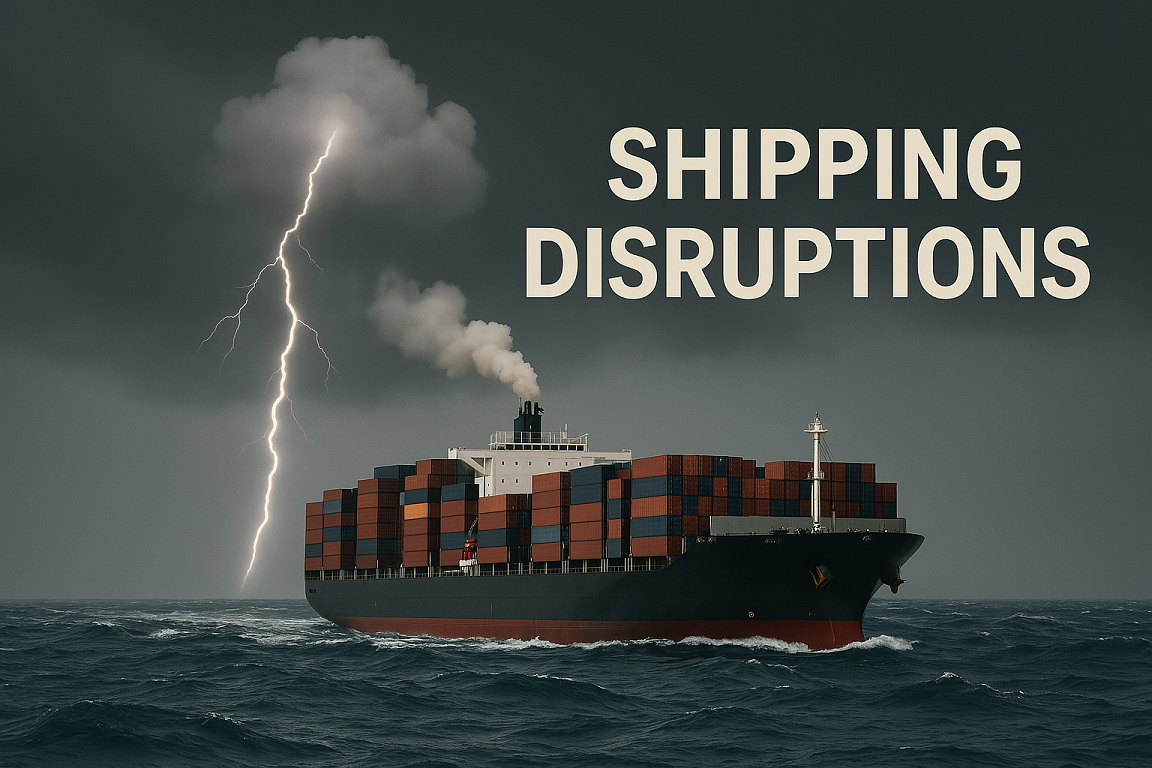Explore the causes, effects, and solutions to global shipping disruptions. Learn how port congestion, geopolitical tensions, natural disasters, and cyber threats affect maritime logistics and supply chains.
🚢📦 What Happens When the World’s Goods Stop Moving?
Imagine walking into your local store and finding empty shelves—not due to lack of demand but because a cargo ship was delayed halfway across the world. In our hyper-connected economy, shipping disruptions can shake industries, delay essential goods, and cost billions in lost revenue.
From COVID-era chaos to recent Red Sea conflicts, global shipping disruptions are becoming more frequent, more complex, and more impactful.
What Are Shipping Disruptions?
Shipping disruptions refer to any interruption in the normal movement of goods through maritime, port, and logistics systems. These can be sudden (e.g., war, strikes) or slow-burning (e.g., port congestion, regulatory changes).
🔍 Common Causes of Shipping Disruptions:
-
Port Congestion and Labor Strikes
-
Geopolitical Conflicts and Sanctions
-
Natural Disasters (e.g., hurricanes, tsunamis)
-
Pandemics (e.g., COVID-19)
-
Cyberattacks on Port or Logistics Systems
-
Accidents (e.g., Ever Given stuck in Suez Canal)
-
Changes in Regulations or Trade Policies
🚨 A single blockage in a major waterway like the Suez or Panama Canal can disrupt 12% of global trade in just days.
⚓ Why Shipping Disruptions Matter
✅ For Beginners & General Readers:
-
Affects delivery of groceries, electronics, medicine, and fuel
-
Raises prices and reduces product availability
🎓 For Students & Researchers:
-
Offers insights into global trade, logistics management, and supply chain resilience
-
Real-world applications for simulation models and forecasting algorithms
⚓ For Maritime Professionals:
-
Disruptions require voyage replanning, risk assessment, and communication with ports and clients
-
Influences vessel scheduling, fuel use, and crewing plans
💼 For Companies & Marketers:
-
Impacts inventory flow, pricing strategies, and customer satisfaction
-
Creates demand for agile supply chains and real-time tracking solutions
🚧 Examples of Major Shipping Disruptions
🚢 The Ever Given Blockage (Suez Canal, March 2021)
-
A 400-meter vessel ran aground, halting over 400 ships
-
Delayed cargo worth $9.6 billion per day
-
Led to global supply shortages and rerouted traffic via Cape of Good Hope
🌍 COVID-19 Pandemic (2020–2022)
-
Lockdowns, container shortages, and crew change crises
-
Spike in freight rates and port congestion from LA to Shanghai
-
Shift toward nearshoring and digitalization
💣 Red Sea Attacks (2023–2025)
-
Vessels rerouted around Africa to avoid missile threats
-
Delay in essential cargo (e.g., oil, electronics) from Asia to Europe
-
Insurance premiums and freight costs soared
🌀 Panama Canal Drought (2023)
-
Climate change led to low water levels, reducing vessel draft
-
Long waiting times and loss of cargo capacity
📈 Latest Trends & Strategic Responses
🌐 Smart Ports & Real-Time Tracking
-
Ports implement IoT sensors, AI-driven logistics, and blockchain platforms
-
Example: Port of Hamburg’s smart terminal automation
🔐 Cybersecurity Measures
-
As digitalization grows, ports strengthen firewalls, backup systems, and crew cyber-awareness
-
IMO enforces cybersecurity compliance in ISPS Code updates
⚓ Resilient Supply Chains
-
Diversification of suppliers and routing
-
Use of freight visibility platforms and digital twins for predictive analysis
-
Emergency stockpiling for essential goods
🤖 Maritime AI and Automation
-
Use of AI for predictive port congestion, weather forecasting, and vessel scheduling
-
Rise in semi-autonomous vessels to manage route delays
🔎 Impact by Sector
| 🏭 Sector | 🔄 Impact of Disruptions | ⚠️ Example Case |
|---|---|---|
| Retail | Delayed fashion/electronics restocks | Amazon shipment delays in 2021–22 |
| Energy | Oil/gas price spikes due to shipping slowdowns | Tankers rerouted during Red Sea missile threats |
| Healthcare | Drug shortages or delayed medical equipment | PPE & ventilator backlogs in early COVID-19 |
| Automotive | Production delays due to chip/logistics issues | Global chip shortage worsened by shipping delays |
📊 Fast Facts & Stats
-
💸 Global shipping disruptions cost $81 billion in 2022 alone (McKinsey)
-
⚠️ 60% of CEOs say supply chain is now their top risk concern (PwC, 2024)
-
🚢 Over 11 billion tons of goods are transported by sea each year
-
🌍 The Red Sea handles nearly 15% of global container traffic
❓ FAQs – People Also Ask
❓What causes shipping disruptions?
Shipping disruptions are caused by port congestion, geopolitical conflicts, labor strikes, natural disasters, cyberattacks, and infrastructure blockages.
❓How do shipping disruptions affect prices?
They reduce supply, increase transit time, and raise freight costs—leading to higher consumer prices globally.
❓How long do shipping delays usually last?
Depends on the cause. Minor port delays may last days; geopolitical crises or canal blockages can disrupt trade for weeks or even months.
❓What is being done to solve shipping disruptions?
Solutions include smart port investments, digital logistics platforms, cybersecurity upgrades, and diversified trade routes.
🧭 Conclusion: Navigating Uncertainty with Innovation and Resilience
In a world increasingly shaped by global interdependence, shipping disruptions are no longer rare—they are recurring. But with technology, adaptability, and cooperation, the maritime industry can navigate through these waves of uncertainty.
From predictive analytics to port automation, the future of shipping depends on how well we prepare today.
🌐 Want to dive deeper into global logistics and maritime intelligence?
Visit MaritimeEducation.com for expert articles, training programs, and maritime innovation insights.


